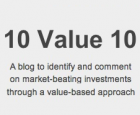Following on from a previous excursion into Return on Equity, and the very good debate which ensued on, I have been pondering further on how to identify and recognise what constitutes a great company.
Why Great?
It sounds like a redundant question, but why the interest in great companies? To paraphrase the likes of Buffett and Co, they would rather buy a great business at a fair price, rather than a fair business at a great price.
This makes perfect sense as the stronger a business is (and is likely to remain so in the future), the stronger the likelihood that future profitability will increase. Get the quality business at a discount and then you can make a killing a la Greenblatt. I may have come to it a bit late, but there seems to have been a lot of excellent analysis and discussion around the subject recently, particularly with UK Value Investor's screening based on ROE and other attributes, and Richard Beddard's Herculean efforts in attempting to apply Greenblatt's Magic Formula to the UK with ROA being a key component. I have been taking a closer look at other ratios that are commonly used alongside ROE.
Useful Tools for the Tool-kit?
1 - Return on Assets (ROA). ROA = Adjusted Net Income / Total Assets
Adjusted Net Income = PAT + Interest (and the tax effect) - to show (kind of) operating profits without the cost of the capital base (ie interest)
Total Assets = Net Assets (opening or average)
Observations. Trying to adjust for interest and the tax effects is fiddly (Sharelockholmes in its ROTA calculation gets around this by using EBIT (I think)). Net Asset Value will include book values of intangibles and goodwill, and fixed assets, all of which may be very detached from market value.
2 - Return on Capital (ROC)
ROC = EBIT / (Net Working Capital + Tangible Assets )
NWC = net current assets/liabilities - ie stock + debtors + cash - current liabilities. Cash should be operating cash
TA = opening or average book value of Tangible Assets
Observations. This is very similar to Greenblatt's Magic Formula measure, although adjusting for surplus cash remains problematic. At least intangibles and goodwill are excluded from Assets, but there is still the issue of tangible assets at book cost. Maybe…






